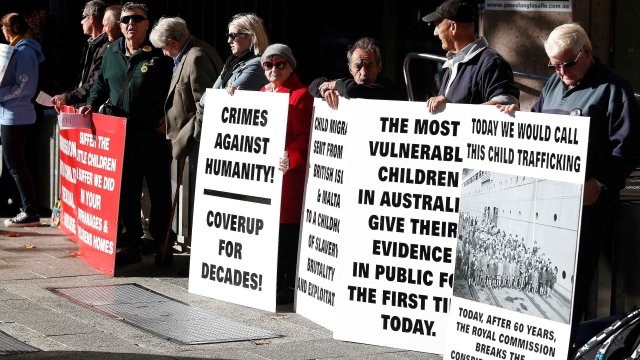
The Royal Commission into the Institutional Responses to Child Sexual Abuse was set up in January last year, after decades of campaigning by victims.
Led by Justice Peter McClellan, the first public hearings began in April last year and apply only to children sexually abused up to the age of 18. It does not include physical or emotional abuse.
The Commission has so far received 11,900 calls, almost 5000 letters and emails, and has heard 1500 private sessions by victims. Any one individual story is first heard in a private session and after all the evidence is collected, a public hearing occurs as an example of the abuse that occurred in that particular institution.
From these figures, it can be seen that the sexual abuse by institutions in Australia occurred on a large scale. There are estimates that only 10% of all the victims have come forward.
Many of the victims are frustrated and concerned that there will be no satisfactory result from the Commission. There has been no mention of compensation for the hundreds of thousands of victims and the victims fear the institutions and churches will not be held accountable for the abuse that took place.
There is no mechanism for the Commission to bring charges. This is partly a result of the terms of reference of the Commission, which are to only investigate the response of the institutions to the sexual abuse, to prevent it happening again.
Lewis Blayse was allegedly a victim of child abuse by the Salvation Army at its Alkira Home in Indooroopilly, Queensland. He died of an aortic aneurysm in February, the night after he was interviewed by ABC’s 7.30.
Blayse began his campaign in 1990, when he came across victims of the Bexley Boys Home, where a paedophile ring was allegedly set up by Salvation Army staff. Blayse was instrumental in getting a Royal Commission established. He desperately wanted to give evidence about 20 boys who had been molested, many of whom are now dead.
Another deep concern is that churches are receiving government grants to offer counselling to the victims; this includes the Salvation Army, the Catholic Church and the Anglican Church. Further, many of the same organisations accused of abuse are being paid to offer a service to trace victims’ families.
The victims want an independent counselling service, and do not want any of the organisations to be given public funds for any social welfare service. They do not want an apology but financial compensation for their lives that were destroyed by their sexual abuse as children.
Emily Lavery and Sarah Morgan say they were both abused by government institutions. They spoke to GLW about the Commission.
Morgan and her four-year-old sister were taken away to an orphanage in suburban Melbourne when she was just seven years old. The orphanage was run by the Social Welfare Department of the Victorian government.
Her parents were both heavy gamblers and after they fought in public on the street, the police came and took her and her sister away. Morgan says she was sexually abused at the orphanage by staff for a year, and an older boy bashed her sister, before her father kidnapped the two of them and absconded to Adelaide.
Lavery was brought up by a middle-class family who lived on the Central Coast. Her mother, a staunch Catholic, was emotionally cruel to her throughout her childhood.
At 15 years of age, she tried to commit suicide by taking an overdose. The local hospital pumped her stomach but she was then taken to a psychiatric hospital. She says a male nurse, who also bashed her, sexually assaulted her in the first week.
She was extremely agitated and so she was drugged, locked up in a freezing room with no bed, and not given food for days.
She ran away but was put in another psychiatric hospital until she was 18, but a sympathetic nurse believed that she was not mentally ill and released her. However, she had lost all chance of a decent education. The director of the hospital later told her she got into the system because of the suicide attempt, her parents did not want her and there was nowhere else to put her.
Lavery also feels strongly that those children who were abused in a family situation and not an institution should also have the right to tell their story through a Royal Commission.
Nicky Davis says she was a victim of a paedophile priest from the Catholic Church when she was only 12 years old. She was part of an international delegation who went to Rome to protest the canonisation of Pope John Paul II in April this year.
They protested because Pope John Paul II had been pope for 27 years and did nothing about the sexual abuse even though the survivors had made hundreds of official complaints.
Some priests, who had been child victims, had themselves given the pope huge dossiers, documenting the abuse. The canonisation was a whitewash of the criminal abuse to wipe away the dirty history of Pope John Paul, Davis told GLW.
“The state organisations, the Churches, the Scouts organisations, the police and the courts, all made a very determined conspiracy to cover up the crimes.”
There were 500,000 forgotten children, including Aboriginal children, who were in institutions during the 20th century in Australia.
As Blayse said in his final interview: “Let no child ever walk this path again. If the Royal Commission does its job, this shouldn’t happen.”